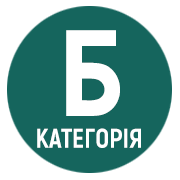STRUCTURAL AND SEMANTIC CHARACTERISTICS OF ONOMATOPOEIA IN THE UKRAINIAN LANGUAGE
DOI:
https://doi.org/10.32782/2412-933X/2024-XX-7Keywords:
onomatopoeia, lexeme, onomatopes, semantics, structureAbstract
The article deals with sound imitation (onomatopes) – words that reproduce the sounds of real life around us. In particular, the structure and semantics of onomatopoeic words of the Ukrainian language were studied on the basis of the works of the modern Ukrainian writer Lyuko Dashvar, who skillfully reflects the real language situation in society. Traditionally, in linguistics, onomatopoeic words have the status of a word. They are considered either as a separate group of exclamations, or as words standing next to them, but not part of them. The research substantiates the expediency of considering onomatopes as a separate group of words, since, unlike exclamations, they have no connection with the world of the speaker, with his emotions, feelings and manifestations of will. Semantic groups of onomatopoeic words are identified, and their function in the work of art is analyzed. Attention is drawn to the attraction of a significant number of onomatopoeia to polysemy, their ability to get along as part of metaphors. Synonymous series of onomatopoeic words were identified, and the stylistic marking of onomatopoeia was clarified. It has been proven that with the help of onomatopoeic words it is possible not only to reproduce the moment of sound, but also to paint a whole sound picture, to convey various sounds of the environment, their melodiousness, volume, rhythmicity, repetition, etc. Reduplicated forms of onomatopoeic words are a powerful expressive means of language. Repetition of certain sound combinations in onomatopoeia or graphic lengthening of vowels demonstrate the intensity and duration of the sound. Such lexical units are clear, bright, they seem to add sound effects to the expression, which significantly emphasize the language of the artistic work. It was concluded that the sound imitation is used in artistic texts as additional means of sound expressiveness, but in the work of Lyuko Dashvar, they act not only as expressions of a sound sign of an action or the action itself, but also, thanks to the skill of the author, through the sound image of the action, they represent the phenomenon itself, vividly, expressively, sometimes emotionally reflecting the realities of the surrounding life.
References
Вихованець І. Р., Городенська К. Г. Теоретична морфологія української мови ; за ред. І. Р. Вихованця. Київ : Пульсари, 2004. 398 с.
Мацько Л. І. Стилістичні функції звуконаслідувальних слів. Культура слова : Республ. міжвід. збірник. Вип. 22. С. 35–39.
Словник української мови у 20 томах онлайн. [Електронний ресурс]. Режим доступу: https://1677.slovaronline.com.
Словник української мови: в 11 томах / за ред. І. К. Білодіда / Інститут мовознавства АН УРСР. Київ : Наук. думка, 1970–1980.
Смаль-Стоцький Р. Примітивний словотвір. Варшава, 1929. 200 с.
Коваль А. П. Практична стилістика сучасної української мови. Київ : Вид-во Київ. ун-ту, 1978. 398 с.





